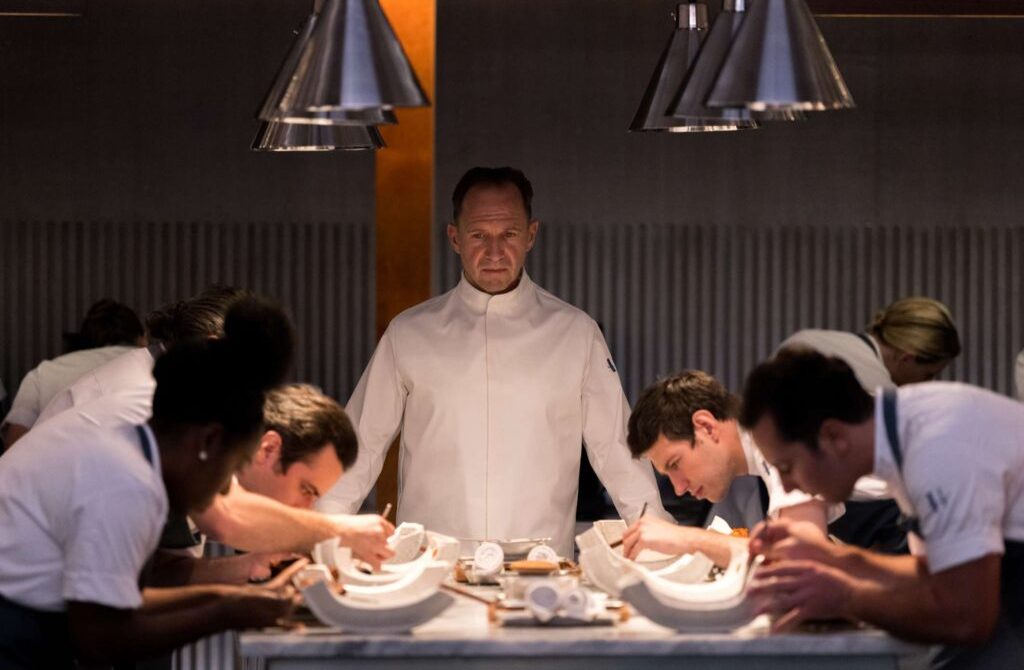During the Tet holiday, my best friend suggested I watch two films: Hunger and The Menu. Though both revolve around food with tantalizing, lavish dishes, their content is far from “easy to digest.”
I found these films profound and connected in certain ways, so I decided to write a combined review to share my thoughts. This is a subjective reflection, and the films’ messages may carry multiple layers—some details I might not fully grasp. To experience them completely, I recommend setting aside time to watch them yourself.
Hunger
The film opens with renowned chef Paul preparing a meal in the garden of a wealthy family. He exudes strictness and meticulousness in every detail. Chef Paul makes no effort to hide his smugness or the control he wields over the dishes he’s paid to create.
In scenes like instructing how to eat lobster at the start or slicing grilled meat near the end, Paul always positions himself above the diners, looking down.
This stance resembles how an owner feeds a pet. It seems caring on the surface but harbors a need for control, asserting dominance by granting favor to a lesser being. Why does a talented chef live with such an odd demeanor? Watch the film to find out.
A small hint: the name “Hunger,” which Paul brands himself with, suggests he doesn’t see people as human when they’re hungry. To him, they’re animals driven by primal instincts—but what’s more unsettling is that human hunger is never fully satisfied. Food isn’t just for sustenance; it’s a display of status, power, and wealth in society. The more they consume, the hungrier they become.
After Paul’s gripping moments, we shift to Aoy. Aoy is a young woman who inherited a stir-fried noodle shop. Like many her age, she’s dissatisfied with the modest stall filled with everyday customers and the constant smell of frying oil. She yearns for a chance to become exceptional. This mindset leads her to Paul, and Paul introduces her to the culinary world of the elite.
At this point, most might expect a classic tale: “good deeds pay off” or “where there’s a will, there’s a way.” Aoy trains hard, her talent is recognized, and she rises to wealth and success, no longer reeking of grease. The film would end with her beaming beside a rich, accomplished man who adores her unconditionally after a chance meeting and unwavering support.
Thankfully, the movie doesn’t take that route.
That would’ve made its deeper message feel forced. Hunger isn’t about “success” but the human craving for it. Aoy’s desire to rise isn’t wrong, but the problem lies in her inability to know when to stop or consider the cost: success gained just to win a crowd’s approval while denying others’ worth.
Paul, the one who came before, craved, paid the price, and succeeded. What’s his success? Beyond fame and money (which seem to make him more a tool than a person), it’s his harshness with colleagues, a quiet resentment toward the rich diners he serves, and a kitchen fire that offers no warmth. It’s a hellish flame consuming creatures and the wealth of those chasing extravagance.
When discussing love in cooking, Paul bluntly rejects Aoy’s view. He can’t see what he lacks. To him, diners pay big for good service, and he cooks for cash. I feel a twinge of pity for Paul—a genius whose character has been so ravaged it’s nearly beyond redemption.
Aoy eventually tastes success through flattery, but also envy and deceit. At her destination, she realizes she doesn’t belong in that ruthless world. Everything has a price, echoing the notion that “what money can’t buy, lots of money can”—Paul was partly right. Having grown up among the elite, he knows them and their tricks. “Special” isn’t always dazzling, and the peak is closest to the abyss; blinding glamour hides the shadows.
The praise and critiques from arrogant, wealthy diners are never sincere—just ploys to feed their hunger.
So, I don’t see the final showdown between Paul and Aoy as pure rivalry. As Paul says, he wants to teach her a lesson—arrogant, yes, but I believe he senses Aoy’s goodness and tries to save her in his own way. Her flame still holds warmth, untainted like his, and one kitchen turned inferno is enough.
That night’s events jolt Aoy out of her dream of a glamorous yet humane world, where happiness hinges on success. She returns to her noodle shop, serving ordinary folks. Confidently starting with what she has, Aoy realizes what’s hers will stay hers, and what isn’t can’t be forced. Rising doesn’t mean becoming someone else or clawing for attention—it’s accepting who you are and striving to grow.
The film doesn’t conclude but invites reflection on life’s facets, like professional ethics and the widening wealth gap—a tension that escalates dramatically in The Menu.
The Menu
This isn’t a sequel to Hunger but a standalone story with its own plot, setting, and characters. Still, I imagine it as a possible fate for Paul if he clung to his ways until the end.
The Menu centers on a dinner at the exclusive Hawthorn restaurant, isolated on an island, led by Chef Julian Slowik. The guests are affluent, high-status individuals (most brimming with superiority, often asking, “Do you know who I am?”). Among them are Tyler and Margot—Margot only learns on the island that she’s a last-minute substitute for Tyler’s ex-girlfriend.
Margot is blunt and true to herself, traits that captivate Slowik. He meets her privately to ask why she isn’t eating. She says his dishes are too elaborate and pretentious to be real food. When he presses her on who she is—expecting a haughty spiel about status or lineage—she simply replies, “I’m Margot.”
After a fleeting moment of surprise, Slowik gives her a choice, making her the only guest not bound to the dark plan he has for tonight’s diners: a final feast on their final night.
As Margot ponders, Slowik savors the guests’ fear, unveiling their dark secrets via images on cornbread. He then confesses his own sins for punishment. This terrifying ordeal unfolds with each course. As death looms, the guests lose all joy in eating or “culinary art.” They didn’t eat to live—they lived to eat.
Slowik deems himself guilty for indulging this. He once traded passion for money and fame, slowly losing his ethics and the pure joy of cooking good food. For years, to cater to the wealthy’s vanity and odd tastes, he and his team enforced discipline, turning the kitchen into a barracks, transforming fresh ingredients into overblown, fanciful dishes for profit.
While some starve worldwide, Slowik strives to please the overfed. Satisfying them earns him status, wealth, and restaurant power. His talent never truly sates them—they devour his work without valuing it. Day after day, he watches his refined creations chewed by shallow people instead of savored. In the end, he becomes what he despised, as tyrannical and unreasonable as they are.
But Margot confronts him. It’s been years since he last heard a bitter yet honest critique of his actions. At the end, I see Slowik’s peaceful smile when she names her requested dish—a true meal to nourish, not feed greed or selfishness.
The ending might surprise you. Some mistakes can be fixed, others only at a steep cost, and some can’t be undone at any price.
In desperation, the pitiful guests offer Slowik a figure to spare their lives. But here, fire shifts from a benevolent bringer of plenty to an indifferent reaper, unmoved by numbers or status. The idea that “what money can’t buy, lots of money can” doesn’t always hold—especially for someone like Slowik, whose heart burned out in torment. He sold his soul once; there’s nothing left to sell. Ending the cycle of transactions, Slowik settles his debt.
In Place of a Conclusion
Eating reveals much about us. At a lavish feast, we sense the intent behind the invitation. People judge and assess each other through food. Eating loses its basic purpose, becoming a tangled equation. That’s bad for digestion—calculating bites strip away flavor, the cook’s effort, and good ingredients.
If hunger and poverty persist, compassionate souls might hesitate to tout “culinary art” or “luxury class.” I believe they tread humbly, knowing lasting happiness for them and their families is hard when surrounded by misery.
Hunger and The Menu provoke thought. “A bite is a blight; lose one, and rage flips your gut”—if that still rings true, are we truly cultured?















